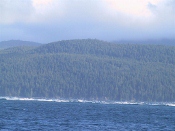MVDirona.com |
||||||||||||||
|
|
|
|
||||||||||||
|
Wind Against Current In Johnstone Strait
One morning, with the wind blowing between 30 and 40 knots from the north, we decided to find out just how rough Johnstone Strait was with an opposing max ebb current. We would discover that it was both "not so bad" and "really, really awful"—all depending upon location. We put on our inflatable PFDs, had our big Type I's handy, lashed everything down both inside and out, and nosed out of Port Harvey with the intention of returning right back if the water was too rough.
The conditions were surprisingly good—the water was fairly smooth and we were taking very little spray over the bow. We continued past Port Neville and Sunderland Channel without any problems, feeling that the "wind-against-current" concern in Johnstone Strait was a little blown out of proportion, until we hit the tide rips at Kelsey Bay. The seas went from relatively calm, to towering, closely-packed breaking waves with their tops being blown off by the high winds, not far beyond which we could see smooth, calm water again. The waves were in excess of ten feet high and strung completely across the channel, with no way around them. We could have just turned back at this point, but part of the reason we were out there was to evaluate the conditions, so we continued on.
Working against the rip required a substantial effort at the helm. We would head Dirona up a steep wave at maximum throttle, steering aggressively to maintain course, come off the throttle as the wave crested, riding the top before slowly sinking down the other side. Then we came back on the throttle again to climb the next one. As we descended into each wave, the bow gradually sank into it and water poured over the sides, similar to a gentle tidal flow, such that the entire bow was awash with over a foot of water. Because it was clear, non-frothy water on the smooth side of the wave, however, we could see right through it to our deck, which was most unusual.
Our conclusion is that with a strong wind running against the current, entering Johnstone Strait should not be avoided outright, but it certainly can live up to its reputation. You definitely want to stay away from any areas marked with tide rips, but careful runs might be managed without much discomfort if you first evaluate the conditions and are prepared to turn back if necessary. If we had simply gone down Sunderland Channel instead of proceeding south towards Kelsey Bay, we would have had no problems at all.
|
||||||||||||||
| Comments or questions? Feel free to contact us at Jennifer@mvdirona.com or jrh@mvdirona.com. |
Copyright 2012 Jennifer and James Hamilton |
|||||||||||||





